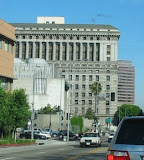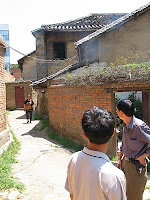Selah: Stop and Marvel
Thursday, March 27, 2008
Both as a novelist and Bible teacher, I enjoy Athol Dickson. I also follow his blog. Today he posts about an amazing observation concerning the meaning of YHWH, the secret name of God.
Descanso Gardens
Sunday, March 23, 2008
One of my favorite memories from thirty-six years ago, during the summer Vicki and I were courting, was some time spent at Descanso Gardens, in La Cañada, California. Vicki remembers going there once, and her strongest image is of sitting on a bench under an arbor that had a vine growing over it. I think we went two or three times, and the image I hold dear is sitting on a thick bed of leaves in the middle of a Camellia forest. Now that Mataikhan lives just up the street, we’ve wanted to go by again and see it. We picked a perfect afternoon.<
The Camellias were in full bloom, but so were the Daffodils, and Tulips,And Lilacs.Oh, and Camellias,And Bird of Paradise,And Bromeliads, And Lilies, And did I mention Camellias?We also enjoyed the Japanese Gardens, And a variety of ponds, fountains and waterways. And have I mentioned the Camellia forests?Thirty-six years later, it all just keeps getting better and better.
Great Earthquakes I have known: Quake #3, Colombia, 1994
Friday, March 21, 2008
Now that I am back from Mount Hermon, I can get back to my series remembering the most dramatic earthquakes that I’ve personally experienced.
Colombia, near the base of Nevado del Huila Volcano, June 6, 1994, (6.4 Richter). I was on the ground floor of a four story building in Bogotá, nearly two hundred miles away from the epicenter, sitting on a sofa and reading the newspaper. When everything began shaking, my first thought was that I was too far away from anything that I could potentially get under, so I sat where I was, while people streamed down from upstairs. It seemed like the quake went on for a very long time (maybe 20 or 30 seconds, but time during an earthquake may not correspond to normal time), so I eventually did get up and walk outside. Although some buildings were damaged in Bogota, the worst damage near the quake came from the lahar that followed. The quake shook a giant hillside into the Paez River, which then backed up to create a lake, which then washed out the dam and sent a 100 foot high wall of mud at 60 miles-an-hour down the valley. Several hundred people were washed away by this lahar, perhaps over a thousand. The number was hard to assess because many of those lost had been members of an outlawed band of revolutionaries, or they had been illegally growing heroin poppies
The area around Nevado del Huila belongs to the Paez and Guambiano people. I had two very good Guambiano friends at the time, a husband and wife. When they had not heard news from their families after a month, the husband made the very laborious trip by bus, to see what had happened. He was not a picture taker, but I bought him three disposable cameras, and asked him to take as many photographs as he could.
Burning Mount Hermon at Both Ends
For five days straddling last weekend, I took part in the 2008 edition of the Mount Hermon Christian Writers Conference. I have now been home long enough to almost catch up on my sleep, but only to barely begin digesting all the information I picked up, and to try to remember all the people I met.
My 'Major Track' consisted of nine hours of workshop led by Randy Ingermanson. Randy's an interesting guy--physicist turned novelist--and I enjoyed getting to know the other members of the crew, as well. They helped me see some new ways of looking at my story.<
I bunked with a couple of interesting fellows. Norris Burkes writes a syndicated column from his back ground as a chaplain in hospitals and the military. Lawrence Darmani (below, on the front porch of our cottage) came all the way from Ghana. He has published both fiction and poetry, and is the Africa Regional Trainer for Media Associates International, a ministry that trains and encourages writers, editors, and publishers in parts of the world that lack a history of printing their own literatures.Mount Hermon is a beautiful location. Therein lays my biggest regret: there was so much going on, I barely had time to take in the scenery.
Tagged by a Meme While Shooting Polaris
Wednesday, March 12, 2008

I have been tagged for a meme from Slowlane. I've never responded to a meme before, but Slowlane and I have a special relationship, and besides, while racing to finish an assignment before I leave town for a writer's conference, I had been thinking how long it had been since I posted anything new on my blog.
THE RULES:
Look up from the computer, look around the room where you're sitting and pick up the closest book. Open the book, turn to page 123, count down to the fifth sentence on that page, and then post the next three sentences.
Quite conveniently, this meme arrived while I was sitting at my computer writing a response for a book my "Contemporary Memoir" class will be discussing tonight. So right at my elbow, I have a copy of Shooting Polaris: A Personal Survey of the American West, by John Hales. John was professor for a Creative Non-Fiction workshop I took three years ago, and ranks as one of my all-time favorite teachers, and I am very much enjoying his book. During the 1970's, while going to school and beginning a teaching career, John worked summers with teams surveying some of Utah's most rugged wilderness. I happen to have another document open with this introductory paragraph:
Context has almost an infinite number of facets. In Shooting Polaris, John Hales unwraps his own coming-of-age story in an ever-widening study of these varied interlocking and overlapping dimensions in which each human being must orient ones’ self: time, space, nature, technology, intellectual traditions, faith traditions, family, social networks, romantic attachments, occupation, morality, and more.
Unfortunately, page 123 has only the last four-and-a-half sentences in a chapter, so I must turn to page 124, which begins thus:
I learned about time, and about the way time flows through and beyond a person's life, from reading names and dates carved nearly a half century before into the soft white skin of a quaking aspen. I was seven years old. My family had pitched our tent in a Forest Service campsite situated where the pines and spruces of a steep mountainside gave way to the aspen groves that carpeted the gentler slopes of Snow Basin, a bowl-shaped valley high in the Wasatch Mountains of northern Utah, not far from where I grew up.
Now I have to figure out who to tag, and how to tag them.
I guess I would like to tag John Hales, but I don't even know if he has a blog. So John, if you see this, leave a comment.
Next, I would like to tag my new son-in-law in Brazil, even if he has to post on Caedmonstia's blog, or start one of his own. I will make the effort to decipher the Portuguese.
And finally, I would like to tag my future daughter-in-law in China. If the closest book is in Chinese, I would greatly appreciate a translation, preferably into English. Same rules: If you would like to post on Serapio's blog, that's cool. 谢谢。
I didn't see in the rules how many people I'm supposed to tag, but this is probably enough.
Great Earthquakes I Have Known: Quake #2, Coalinga 1983
Tuesday, March 04, 2008
Coalinga, California, May 2, 1983, (6.5, Richter). Caedmonstia might remember this one. We were about 70 miles away from the epicenter. Her mother and I were in the kitchen, with at least one of the kids, and we leaped to stand in the doorway. However, once we were under the doorway, I kind of thought it was a fun little shake. This hit a more rural area than the 1971 quake, but there were six deaths and considerable property damage. Vicki later told me about an aftershock, but I had been driving in the car and didn’t feel it. Personally, we had no lasting effects from the Coalinga quake.
So, how big does an earthquake have to be for people to feel it? The seismological lesson is, folks seated or supine on stationary furniture will detect a smaller quake than people driving in a car.
Great Earthquakes I Have Known: Quake #1, San Fernando (Sylmar) 1971
Monday, March 03, 2008
After I wrote about all the earthquake activity around Guadalupe Victoria, Baja California (which had another 5.0 the next afternoon), Caedmonstia asked, “How big does an earthquake have to be for people to feel it?” Someplace, I’m sure there are wonderful scientific answers to that, such as, “It depends.” But I am thinking more experientially. In this new series, I will be describing the Standout Moments of My Personal Seismological Memory:
San Fernando, California, Feb, 9, 1971, 6:01 a.m., (6.6 on the Richter scale). I was about twenty miles away, on the 5th floor of a UCLA dorm building. It woke me up with the thought that a railroad train was coming through the bedroom. Those who were coherent enough to run to the windows reported seeing a wave of green explosions as transformers went dead across the still-dark city. Sixty five people died in the earthquake (most in one hospital that collapsed). The quake was much worse at my parents' house (a freestanding cabinet fell across my sister and her bed), only about ten miles from the epicenter and downstream from a large earthen dam. For me, it was the only time I ever remember everybody being awake and in line for breakfast when the dining hall opened at 7:00. But for what? Classes were canceled. I had been tutoring ESL at Castelar Elementary School in Chinatown, but the main building was sufficiently cracked that it could never be used again. A mile south of that was the Hall of Justice, which included both the DA’s and Sheriff’s offices, courtrooms, and several floors of jail. It also suffered damage and had to be evacuated and boarded up. It still stands empty, today. That made it difficult for me to research it when I wanted to use it as a location for my novel, Friday 10:03. Eventually, I talked to my father's cousin who had worked there, and it became one of my favorite locales in the book.




















